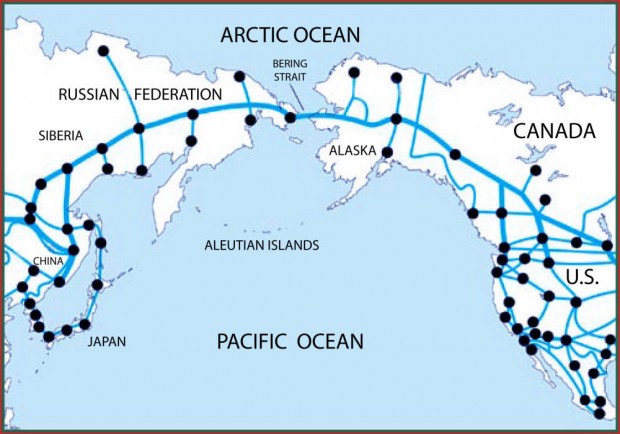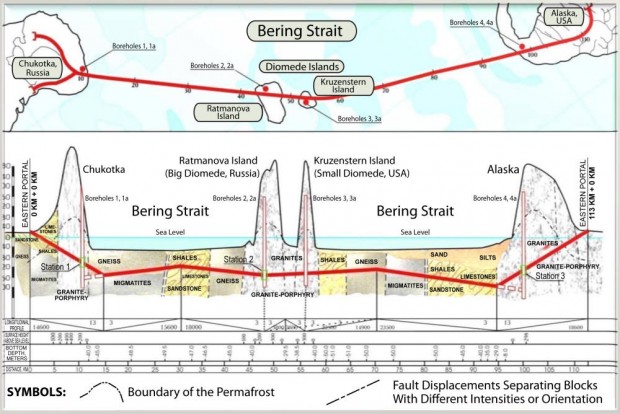 | ||||||||||||||||
| The proposed connection between the US and Russia via inter-continental rail |
This is quite an idea, and it, too, was thought about long ago (a musing of Czar Nicholas II in 1905), but the economics of it are apparently now ripe for the actual mission to take shape. Seems the Chinese are also keen on this, and with three of the largest nations on earth all thinking about doing something, it just might happen sooner than later.
I'm certainly excited by the idea, and I might start saving my pennies to take that train trip (although in reality it would probably be miserable as a passenger and more exciting and easier for a piece of freight to be shipped to me "ground service" from China). This could mean a whole new category of rain service - the ultra-long distance freight express.
So my question is, naturally, how could one model this new ridiculously long route? It would be a great candidate for the continuous model railroad Dynamo concept, of course, but what other ways might this vast and frozen route be tackled? I'm feeling a little silly at the moment, so I might take on the tunnel itself.
"What on Earth is this guy thinking?" Well, I'm thinking that the most important signature element this railroad has to be the bridge and tunnel system that gets the railroad across the Bering Sea. Viewed as either an LDE (a layout design element) or an ODE (an operational design element), the tunnel layout would not be a John Allen subway line, but rather more like an Iain Rice portrait layout that captures the essence of what the railroad is at that point - under water, probably going quite fast, and cold. Some interesting things to model.
 |
| A cross section of the proposed Bering Strait tunnel. How would this translate into a model railroad? |
Capturing those elements would be a fun challenge. Imagine a layout whose backdrop was actually more of an overdrop extending down from the valence and right in your face. A model of a cross section of frigid ocean water and life would be quite stunning. Then below the very narrow strip of train tunnel at eye level would be a think cross section of sand, rock and earthen modeling that would make for an unusual framing for a railroad. The trains would move fast (who wants to slow-poke it through a mulit-kilometer underground and undersea hole), and they would probably be container trains. Maybe a new type of container for this different sort of trip? I would think the locomotives might rate a new look and functionality as well - perhaps ones with sleeping berths and extra fuel compartments integrated into them?
Such a layout would be future-projecting, which doesn't happen much in model railroading. Most of the alternate realities are simply freelance or what-if railroads whose validity comes from being as believable as possible to fit into an existing context. But there are not many (any? Tell me about them if you know of one!) that are set in the future? What happens to the hobby activity when it becomes speculative (like a freelance railroad) and also forward-looking?
The modeler would necessarily become more like a sci-fi author/designer having to extrapolate and extend the railroading of today into a future setting that has new constraints and needs to be designed for. What a great opportunity to experiment and play with scratchbuilding new locomotives, liveries and specialized rolling stock. The scenery would be out of the norm, the presentation unusual at least, and the demand on creativity very high. Might be a good challenge for someone out there who has mastered recreating railroads from memory or research, and who is up to the challenge of designing a railroad mostly from sheer creative vision.
Interesting Article. It would be AWESOME to see this route be built and compete with the newly widened Panama Canal and the (mostly to-be-built) East Coast Ports.
ReplyDeleteI imagine they would load freight much the way as they do currently in the Chunnel that runs below the English Channel. Or perhaps we'll see how they handle freight in the Gotthard Base Tunnel under the Alps (the World's longest and deepest traffic tunnel).
If you're looking for inspiration on futuristic dystopian trains, you can look to the following movies:
* Snowpiercer - A post-apocalyptic train forced to constantly run. The last survivors are forced to live within the perpetually moving train in a high-tension two class caste system: the ultra rich and the ultra poor.
* Insurgent - A futuristic train riding on two parallel spaced tracks with the center span equal to the out track spans. The engine runs on the center span and pulls two strings of cars on the outer two tracks. Interesting configuration!
* The Hunger Games Series - Who hasn't seen the Hunger games in which the contestants ride aboard the high-speed futuristic train across the 12 districts to the capital city where they will compete in the Hunger games.